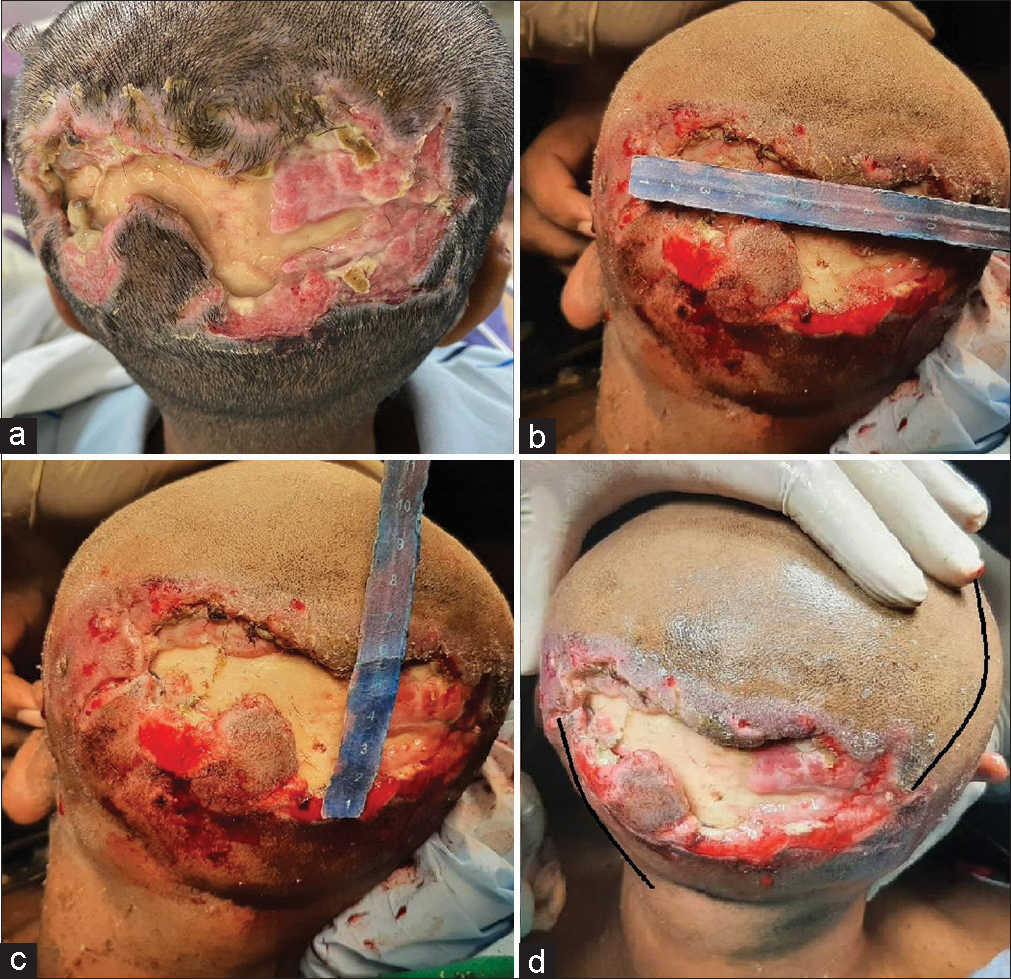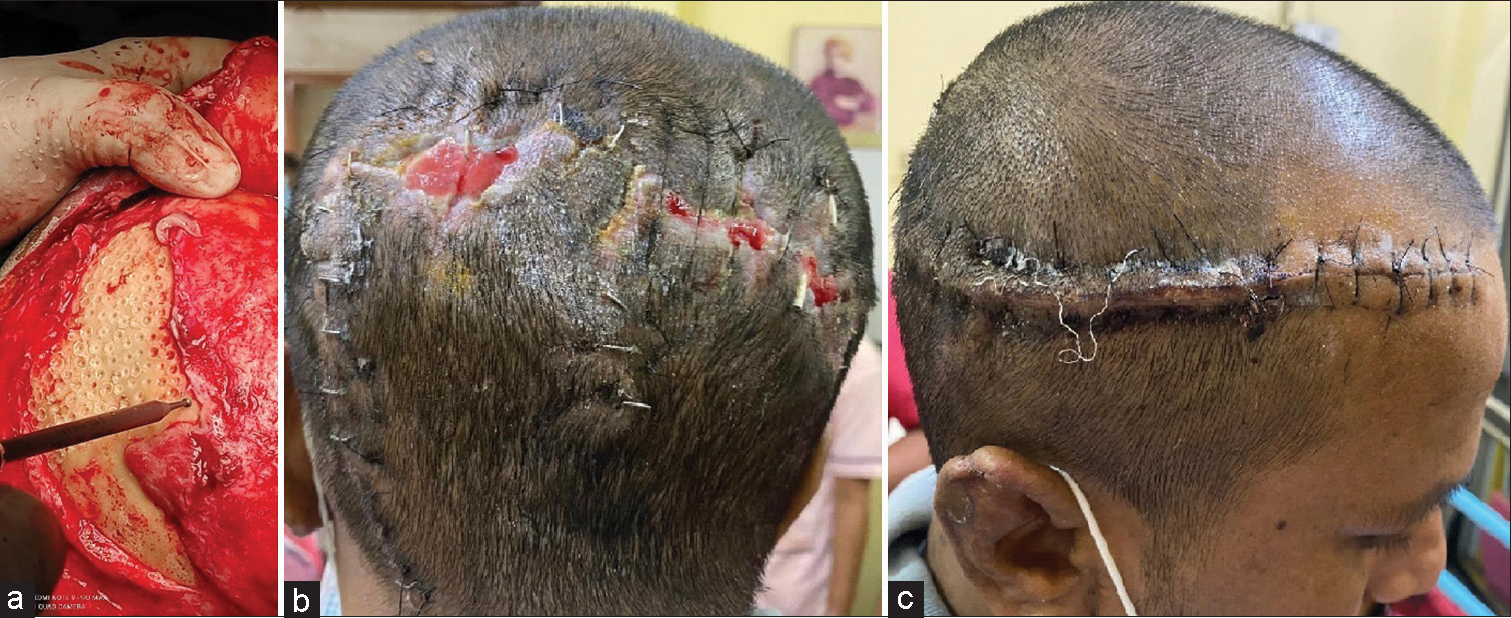Translate this page into:
Management of delayed presentation of scalp loss with double rotation flaps and multiple calvarial drilling
*Corresponding author: Prasad Krishnan, Department of Neurosurgery, National Neurosciences Centre, Kolkata, West Bengal, India. prasad.krishnan@rediffmail.com
-
Received: ,
Accepted: ,
How to cite this article: Patel S, Bhosle R, Das P, Krishnan P. Management of delayed presentation of scalp loss with double rotation flaps and multiple calvarial drilling. J Neurosci Rural Pract 2023;14:762-4.
Dear Editor,
A 44-year-old man presented to us 2 weeks after a road traffic accident with an irregular area of scalp loss measuring approximately 11 cm * 6 cm with ragged, retracted wound margins and exposed bone that was devoid of pericranial cover [Figure 1a-c]. The margins had unhealthy granulation tissue and could not be approximated to each other even with much effort. A double rotation flap was planned to cover the defect [Figure 1d]. He underwent wound debridement, trimming of unhealthy margins, and double rotation flap cover of the scalp defect after multiple calvarial drillings on exposed bone [Figure 2a]. The arc of the rotation flaps was extended in a gentle curvilinear manner from the corners of the defect and the anterior one was approximately 14 cm in length extending to the right side of the forehead while the postero-inferior one was approximately 10 cm in length extending to the occipital hairline three fingerbreadths behind the left ear. The generous undermining of the scalp in the avascular plane between the pericranium and galea was done to prevent pivotal restraint. The former flap was rotated in anticlockwise and the latter flap was rotated clockwise to cover the defect. The incisions made to raise that the rotation flaps were closed primarily and at one place of the closure of the original defect, the sutures were passed through the tubing of an external ventricular drain to distribute tension equally over the margins and prevent skin necrosis. The wound healed well except for small areas of granulation tissue and sutures were removed at 18 days [Figure 2b and c]. One month following this except for small scabs on the suture line at three places, the wound was normal and hair was beginning to cover much of the scalp [Figure 3].

- Clinical photographs showing (a) neglected scalp wound with skin loss and ragged retracted margins with exposed bone and unhealthy granulation tissue, (b) the side to side dimension of the wound was 11 cm, (c) the superoinferior defect was 6 cm and (d) the proposed line of incision from the wound margins for creating the double rotation flaps is shown in black lines.

- Operative photograph showing (a) multiple calvarial drillings of the outer cortex to expose the diploe being done with a high-speed drill; (b) wound covered and healing satisfactorily with few areas of granulation tissue and no exposed bone with healing of the posterior flap incision and (c) healing of the anterior flap incision.

- Clinical photographs 1 month later (a and b) showing the wound with small areas of scab and satisfactory hair growth over most of the previously exposed area.
Small defects of the scalp can be closed by undermining the galea and pulling opposing margins together, using pulley sutures, or by horizontal mattress sutures passed through soft tubing.[1] However, larger defects cannot be closed by these means and need flap closure to prevent infection of the exposed bone. Rotation flaps are commonly used workhorse flaps that can be used to close a wide variety of scalp defects.[2] The basic principle of this flap is to rotate nearby skin to close a defect by making a curvilinear incision along the direction of the defect to be closed and then pivoting tissue around the axis of the arc that has been made.[3] It is recommended that the length of the arc be 4 times the width of the defect to be closed.[2,3] As this would not be possible in the large defect seen in this case with a single incision, we employed a double rotation flap (extending in opposite directions from the margins of the wound) with each elevated flap covering part of the defect. The undermining of the skin is essential to prevent any restriction of movement (“pivotal restraint”) and ensure tension-free closure of the incision[2] and this was done in our case too. A similar double opposing rotation flap for reconstruction of large scalp defects (>7 cm in size) has been described once previously in the literature.[4]
Finally, as we were unsure about how the flap would adhere to the part of the underlying bone that was denuded of pericranium, multiple calvarial drillings were performed to allow for granulation tissue to pout from the diploe to adhere to the flap. This is a technique described previously (but performed rarely these days) in aiding closure in the scalp and pericranial loss.[5]
Scalp injuries following trauma may sometimes be impossible to close by mere apposition of the wound margins, if there is a large area of skin loss and also in cases of delayed presentation when the wound margins retract away from each other. Attempts to forcibly bring the margins together in such circumstances may result in necrosis of the wound margins or “cut through” of the sutures from the skin. The scalp with its rich vascularity and mobility is an ideal location for the placement of rotation flaps that enables tension-free closure of large defects with the added advantage of allowing normal hair growth in the wound area. Knowledge of the principles of rotation flap closure must be part of the armamentarium of all neurosurgeons dealing with trauma.
Declaration of patient consent
The authors certify that they have obtained all appropriate patient consent.
Conflicts of interest
There are no conflicts of interest.
Use of artificial intelligence (AI)-assisted technology for manuscript preparation
The authors confirm that there was no use of artificial intelligence (AI)-assisted technology for assisting in the writing or editing of the manuscript and no images were manipulated using AI.
Financial support and sponsorship
Nil.
References
- A novel technique of closure of scalp defects under tension. J Neurosci Rural Pract. 2021;12:450-1.
- [CrossRef] [PubMed] [Google Scholar]
- The ideal rotation flap: An experimental study. J Plast Reconstr Aesthet Surg. 2008;61:754-9.
- [CrossRef] [PubMed] [Google Scholar]
- Flap basics I: Rotation and transposition flaps. Facial Plast Surg Clin North Am. 2017;25:313-21.
- [CrossRef] [PubMed] [Google Scholar]
- Double-opposing unilobar rotation flaps in the reconstruction of moderate-to-large defects of the scalp. J Craniofac Surg. 2015;26:e523-5.
- [CrossRef] [PubMed] [Google Scholar]
- Exposed bone with scalp and pericranial loss: Role of multiple calvarial drillings in aiding closure. J Pediatr Neurosci. 2019;14:106-8.
- [CrossRef] [PubMed] [Google Scholar]





